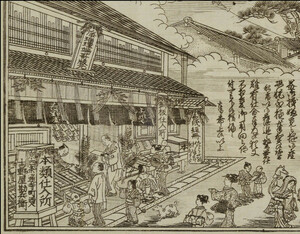This book is what the Japanese would call 銅版 細画帖 dōban saigajō (booklet of copperplate prints). Such prints are sometimes called 新鐫 shinsen (new engravings), to distinguish them from traditional woodprints. The prints are produced on washi paper and glued two by two on a thicker, slightly glossy, micaceous paper. The sheets are then folded and bound together (but not in the fukurotoji manner) to form a book. Our booklet is 16x10.5cm in size and contains 25 prints. It has no daisen, no title page, no colophon, perhaps because it is considered an album rather than an e-hon.
The technique of copper engraving, first used in Japan by the Jesuits in the 16th century, was not used by locals until the end of the 18th century, when Shiba Kōkan learned the technique, and became popular in the mid 19th century through the production of keidaizu (pictures of religious precincts). Lithography only appeared in Japan in 1873. Since copper engraving allows for much finer details than wood carving, the prints can be much smaller. The genre of such prints is 名所絵 Meisho-e, views of famous places, which implies that this is popular rather than fine art, thus not considered collectible at the time, which in turn explains the present rarity and market value of such booklets and prints.
Prints 1-3, 10, 11, 13, 16, 18-21 bear the signature of Okada Shuntōsai (岡田 春燈斎 active 1830-1860). Prints 14 and 15 have his seal. Print 8 is attributed to him by the Art Gallery of NSW. Prints 4, 22, 24 are signed by Shunsentei Chōgetsu (春泉亭 澄月刻 active 1854-81). On prints 22 and 24, the signature mentions that he is a student of Shunto[sai]. Print 23 is signed by Matsuda Rokuzan (松田 緑山 1836–1903). He is the son of Matsumoto Yasuoki (松元 保典 1786-1867), founder of the Gengendō school. Prints 17 and 25 have the name of Suigetsudō (水月堂), which is attributed to Shuntosai by MFA (and by EAL for print 25), but I believe that it is actually the name of the publisher, because prints 4 and 22 by Shunsentei Chōgetsu also bear that inscription1. Print 25 bears the signature Gengendō (玄玄堂), which might be that of Matsumoto Yasuoki or of his son, who both signed that way. The scenes represented in prints 1 and 12 have also been carved by Rokuzan, with slight differences.
The date of publication seems to be in the 1850s, according to the various institutions that have copies of these prints. Print 8 is dated 1859 by the Art Gallery of NSW. Print 12 has the date 1853. Prints 16 and 18 have the date 1849.
All the prints were cropped before being mounted into a book, so the information in the margins is almost completely lost. We retrieved it on the prints of the East Asian Library, hoping that these are from the same edition as ours. The information on the left margin is a serial number (between 43 and 288, different for each print), the size of the print (medium 延形 or large 中形), and one hiragana character (い ろ ほ は). The information on the right margin, when present, is the the publisher and the common name for the title.
 |
Okada Shuntōsai was a renowned copperplate engraver from Kyoto. Together with Matsuda Rokuzan he was a member of "a group of Kyoto artists called Gengendō who popularized images of temples and shrines made as copperplate prints". They adopted the Western perspective and techniques, the latter "relying on sharp lines and dense texture". Their dōban were mostly monochrome, a major difference with woodprints. One of Shuntōsai's engravings "shows a copperplate print business owned by Nishimura Kanbei, located in downtown Kyoto at Shijō Teramachi". Another noteworthy detail is the prominent position in print 2 of the shops in the courtyard, "showing the strong importance of religious and commercial exchange" 2.
 |
| The Dōban shop of Nishimura Kanbei |
1. There are at least two other such cases in the EAL database, one involving Chōgetsu, the other Rokusan. ↩
2. The quotes are from an article by Sherry Fowler, "Views of japanese temples and shrines from near and far: precinct prints of the eighteenth and nineteenth centuries", Artibus Asiae, Vol. 68, No. 2 (2008), pp. 247-285. ↩